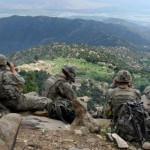President Barack Obama’s Afghanistan policy has been criticised over the years for flip-flopping dangerously through half-measures, premature declarations and fluctuating troop levels.
Last year faced with a resurgent, resilient Taliban and a creeping presence of ISIS, Obama was forced to go back on his promise to bring home nearly all the U.S. troops by the end of 2016. Now the 9,800 American troops currently in Afghanistan are expected to stay through most of this year and if the Pentagon has a say, troop strength may even increase.
The fall of Kunduz to the Taliban last October and the fierce fight to retake the northern provincial capital sobered Obama and Vice President Joe Biden enough to stop talking about ending the mission. In the south, the Taliban attacked Afghan forces in Helmand where an al-Qaeda training camp was also discovered. In December, a suicide bomber killed six American airmen outside Bagram air base.
The last quarterly assessment released by the Pentagon in December 2015 admitted that the “overall security situation in Afghanistan deteriorated with an increase in effective insurgent attacks.” Republicans have always criticised Obama’s penchant for a “calendar-based withdrawal” instead of a “conditions-based withdrawal” from Afghanistan but now even the Democrats say Obama’s decision to announce a deadline was a huge mistake.
The decision to maintain American forces in Afghanistan is welcome but not directly targeting the Pakistan-supported Haqqani Network (HQN) remains a curious and self-defeating element of American policy. This even when at least 14 men from the group are on the U.S. list of global terrorists in addition to the fact that HQN is linked to al-Qaeda, the terrorist group the Americans do go after under their rules of engagement.
The outgoing commander of the U.S. and NATO troops in Afghanistan, Gen. John F. Campbell testified this week that HQN remained “the most capable threat to the U.S. and coalition forces, planning and executing the most high profile attacks in Kabul.”
The incoming commander, Lt. Gen. John Nicholson, echoed the sentiment in before the Senate Armed Services Committee last week. He called the Haqqanis the “number one threat to our forces in Afghanistan” and a “severe threat” to the Afghan government. He also accused Pakistan of not putting “adequate pressure” on the group.
Senator Dan Sullivan, a Republican from Alaska, asked the obvious question: “Can we target the Haqqani Network and the Taliban as part of our CT (counter terrorism) mission?” If the Pakistanis won’t do it, why can’t the U.S. forces take care of the threat?
Nicholson, who has spent more time in Afghanistan than any other top military officer, replied: “They are not a part of that designation right now.” In other words, even though HQN terrorists have attacked the U.S. forces and been implicated in the 2008 attack on the Indian Embassy in Kabul, they can’t be targeted because they are part of the elusive reconciliation process between the Afghan government and the Taliban. The Pakistan-led process is yet to demonstrate any tangible gains but the Obama Administration finds reason to believe that it will one day.
Lt. Gen. Nicholson revealed that it was the responsibility of the Afghan national security forces to go after HQN. The “Haqqanis are principally a focus of the Afghan security forces” even as he agreed that the Afghan national security forces were ill equipped to handle the mission. They have no air power, shortage of mid-level officers and limited capacity to evacuate the wounded.
He also repeated that oft quoted and by now meaningless complaint: HQN enjoys safe havens in Pakistan. American pleas to Pakistan over the years to shut the safe havens have proved fruitless. “When an enemy enjoys sanctuary like that, it’s very difficult to defeat them.” He called it a “mixed story” which requires continuous engagement with Gen. Raheel Sharif and continuous engagement at the operation and tactical level.
By keeping the HQN in operation and keeping the prospect of “reconciliation” alive at the same time, the Pakistan army keeps both U.S. and Afghan forces busy chasing a mirage. While sentiment against Pakistan in the U.S. Congress grows, there is little indication the Obama Administration is willing to take a hard look and put pressure on Pakistan to behave differently.
If not, then 9,800 troops can hardly achieve what 100,000 troops in 2010 or 38,000 in 2014 could not. According to an estimate by the Centre for Strategic and International Studies, the U.S. had spent $641 billion by 2013 to try to bring stability and peace to Afghanistan but its military and political strategy clearly hasn’t achieved the desired results. Perhaps, it is time to think differently about the Af-Pak region.
Seema Sirohi is a Washington-based analyst and a frequent contributor to Gateway House: Indian Council on Global Relations. Seema is also on Twitter, and her handle is @seemasirohi
This article was exclusively written for Gateway House: Indian Council on Global Relations. You can read more exclusive content here.
For interview requests with the author, or for permission to republish, please contact outreach@gatewayhouse.in.
© Copyright 2016 Gateway House: Indian Council on Global Relations. All rights reserved. Any unauthorized copying or reproduction is strictly prohibited


